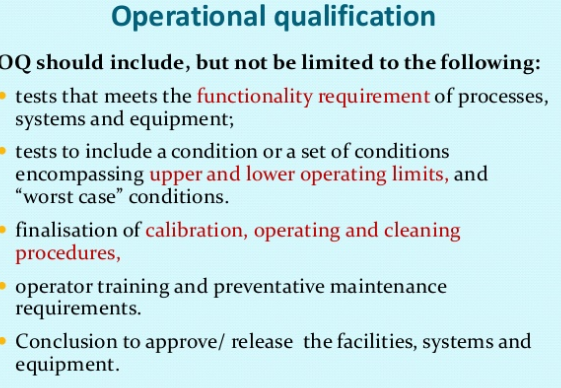


https://www.slideshare.net/DrAmsavelvel/validation-master-plan-115143205
This Operational Qualification (OQ) protocol comes with an interactive standard operating practice (SOP) document as a prefixed introductory document. As you progress through this SOP you are auto populating the OQ. This is a really easy and straight forward document to use. In the preparation of Operational validation protocols, it is important to allow a certain degree of flexibility. This must be debated and justified in the Validation Plan (VP). Should the OQ remain untouchable, until the Installation-Qualification (IQ) is completed and signed off? There are many instances where this is not only undesirable, but senseless and deleterious to project progress and costs. Should every function in a system or piece of equipment be qualified? If so, one must ask about validation progress and costings. It makes little sense to fail something for not reaching a parameter that you are not going to use.
The Operational Qualification includes a review of the Standard Operating Practice (SOP's) for start-up, operational, maintenance, safety, and cleaning / sanitization. The modular process has been followed in constructing this Operational Qualification, in as much that where tests / inspections are standard for systems and or equipment, they are built into the basic protocol. Where they are not they are available as additional test protocols.
Functional and software tests are authored in this stand alone test scrip protocol format. When the OQ is being raised they are pasted in. The document format will paginate them, and automatically add them to the ‘Table of Contents’. They are then part of the OQ. These Test Scripts can be held as Method Statements or SOP's. This allows the generation of a standard OQ that covers all the many items the regulators are looking for, with the facility to have integrated into it, the equipment specific testing tasks. It also means that these stand alone test scripts are available for tasks other than validation, i.e. when system re-testing is required.
It also saves unnecessary testing and re-testing. For example, when a room pressure regime has been commissioned by another party and the completed report is in date and available, is it practical and legal to use it? There is no reason why not, providing it has been authored, and executed using the same documentation practices and procedures as are used in the routine production and execution of validation protocols. The OQ test scrip will be of standard format, the contractors tests (containing the raw data) will be reviewed and data extracted from it.
This data will be used to verify that the Operation Qualification test script acceptance criteria has or has not Operational Qualification Rationale.been satisfied. The raw data from the contractor now forms part of the OQ, and must be appended to it permanently, along with copy calibration certificates for all the test equipment used in obtaining the raw data.
Where you use your own indigenous testing methods contained in an SOP or a Method Statement (or whatever you decide to call them), they must be used in a manner similar to the manner the contractors raw data was used.
The scope of the OQ testing/inspections must include but is not limited to:
- Verification that all loop installations;
- Insert a brief description of what part of the validated product process.
- Insert a brief description of the operational function.
- An integrated loop test verification.
- Testing of alarms.
- Testing of interlocks and permissive conditions.
- Testing of database or data storage integrity.
- Testing of report generation and event chronicle.
- Verification of the functionality of the equipment.
- Challenge of software, where required;
- Review of system functionality to verify compliance with 21 CFR Part 11.
- If system must be 21 CFR Part 11 compliant, verification;
- Testing of security levels to prevent;
- Testing to verify and document 'Power loss Recovery'.
- Testing of all interfaces between;
- Testing for Electromagnetic interference and compatibility.
[
https://www.validation-online.net/operational-qualification.html]
System Requirements and verification of the installation process are usually tested in the Installation Qualification. Input, Processing, Output, and Security testing are usually tested in the Operational Qualification.
For example, the operational qualification might test:
- That each screen accepts the appropriate data
- That an item can be moved through an entire workflow
- That system security has been properly implemented
- That all technological controls for compliance with 21 CFR 11 are functioning as expected